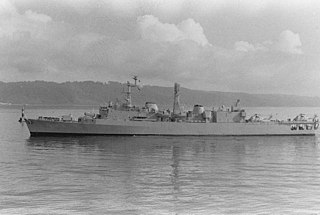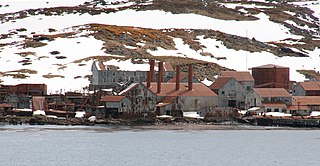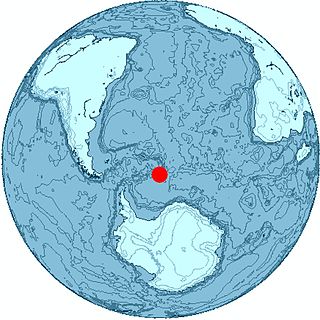 W
WHMS Antrim was a County-class destroyer of the British Royal Navy launched on 19 October 1967. In the Falklands War, she was the flagship for the recovery of South Georgia, participating in the first ever anti-submarine operation successfully conducted exclusively by helicopters. In 1984, she was commissioned into the Chilean Navy, and renamed Almirante Cochrane.
Alfredo Ignacio Astiz is a former commander, intelligence officer, and naval commando who served in the Argentine Navy during the military dictatorship of Jorge Rafael Videla during the Proceso de Reorganización Nacional (1976–1983). He was known as El Ángel Rubio de la Muerte, and had a reputation as a notorious torturer. He was discharged from the military in 1998 after defending his actions in a press interview.
 W
WARA Bahía Buen Suceso (B-6) was a Bahía Aguirre-class 5,000-ton fleet transport that served in the Argentine Navy from 1950 to 1982. She took part in the Falklands War as a logistics ship tasked with resupplying the Argentine garrisons scattered around the Falkland Islands. Captured by British forces on 15 June after running aground at Fox Bay, she sank in deep waters while being used as target practice by the Royal Navy on 21 October 1982.
 W
WCorbeta Uruguay base was an Argentine military outpost established in November 1976 on Thule Island, Southern Thule, in the South Sandwich Islands.
 W
WCumberland East Bay is a bay forming the eastern arm of Cumberland Bay, South Georgia. It is entered between Sappho Point on Thatcher Peninsula and Barff Point on Barff Peninsula. It is nearly 3 miles (4.8 km) wide, and extends 8 miles (13 km) in a southeast direction.
 W
WHMS Endurance was a Royal Navy ice patrol vessel that served from 1967 to 1991. She came to public notice when she was involved in the Falklands War of 1982. The final surrender of the war, in the South Sandwich Islands, took place aboard Endurance.
 W
WFortuna Glacier is a tidewater glacier at the mouth of Cumberland Bay on the island of South Georgia. It flows in a northeast direction to its terminus just west of Cape Best, with an eastern distributary almost reaching the west side of Fortuna Bay, on the north coast of South Georgia. It was named in about 1912, presumably after the whale catcher Fortuna, and is notable for two major events in the 20th Century.
 W
WGrass Island is a conspicuous island lying across the entrance to Stromness Harbour in Stromness Bay, South Georgia. It was known as "Mutton Island" as early as 1912, but since 1920 the name Grass Island has been consistently used.
 W
WGrytviken was the largest whaling station on South Georgia, part of the British Overseas Territory of South Georgia and the South Sandwich Islands in the South Atlantic. The settlement, which is located at the head of King Edward Cove within the larger Cumberland East Bay, was considered the best harbour on South Georgia Island. It was founded on November 16, 1904, by Carl Anton Larsen of Sandefjord, Norway.
 W
WOperation Keyhole was a British special operation to recapture Thule Island in the South Sandwich Islands during Operation Corporate in the 1982 Falklands War. The operation took place from 19 to 20 June 1982.
 W
WKing Edward Point is a permanent British Antarctic Survey research station on South Georgia island and is the capital of the British Overseas Territory of South Georgia and the South Sandwich Islands. It is situated in Cumberland East Bay on the northeastern coast of the island. The settlement is the smallest capital in the world by population. It is sometimes confusingly referred to as Grytviken, which is the site of the disused whaling station, nearby at the head of King Edward Cove.
 W
WLeith Harbour, also known as Port Leith, was a whaling station on the northeast coast of South Georgia, established and operated by Christian Salvesen Ltd, Edinburgh. The station was in operation from 1909 until 1965. It was the largest of seven whaling stations, situated near the mouth of Stromness Bay. One man prominently involved in setting up Leith Harbour was William Storm Harrison.
 W
WRFA Olmeda (A124) was an Ol-class "fast fleet tanker" of the Royal Fleet Auxiliary. The ship was renamed from Oleander after two years in operation.
 W
WOperation Paraquet was the code name for the British military operation to recapture the island of South Georgia from Argentine military control in April 1982 at the start of the Falklands War.
 W
WQueen Elizabeth 2, often referred to simply as QE2, is a retired British ocean liner converted into a floating hotel. Originally built for the Cunard Line, Queen Elizabeth 2 was operated by Cunard as both a transatlantic liner and a cruise ship from 1969 to 2008. It was then laid up until converted and since 18 April 2018, she has been operating as a floating hotel in Dubai.
 W
WARA Santa Fe was an Argentine Balao-class submarine that was lost during the Falklands War. Built by the US during the Second World War, the ship operated in the United States Navy as USS Catfish (SS-339) until it in 1971 was transferred to the Argentine Navy. She served until 1982 when she was captured by the British at South Georgia after being seriously damaged and subsequently sank along a pier, with just her sail visible above the waterline. The submarine was raised, towed out of the bay and scuttled in deep waters in 1985.
 W
WThe invasion of South Georgia, also known as the Battle of Grytviken or Operation Georgias, took place on 3 April 1982, when Argentine Navy forces seized control of the east coast of South Georgia after overpowering a small group of Royal Marines at Grytviken.
 W
WSouthern Thule is a collection of the three southernmost islands in the South Sandwich Islands: Bellingshausen, Cook, and Thule (Morrell). The island group is barren, windswept, bitterly cold, and uninhabited. It has an extensive exclusive economic zone rich in marine living resources managed as part of the SGSSI fisheries. The Admiralty's Antarctic Pilot says that Southern Thule is part of an old sunken volcano, and is covered with ash and penguin guano. There are seals, petrels, and a bank of kelp just offshore, especially around a small inlet on Morrell called Ferguson Bay.
 W
WRFA Tidespring (A75) was a Tide-class replenishment oiler of the Royal Fleet Auxiliary. As a replenishment oiler, her main purpose was to refuel other ships. The ship had a long career in the RFA, entering service in the early 1960s, and finally being decommissioned in 1991.